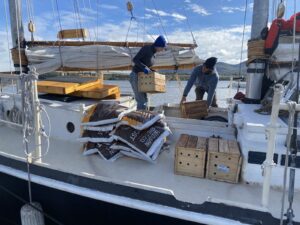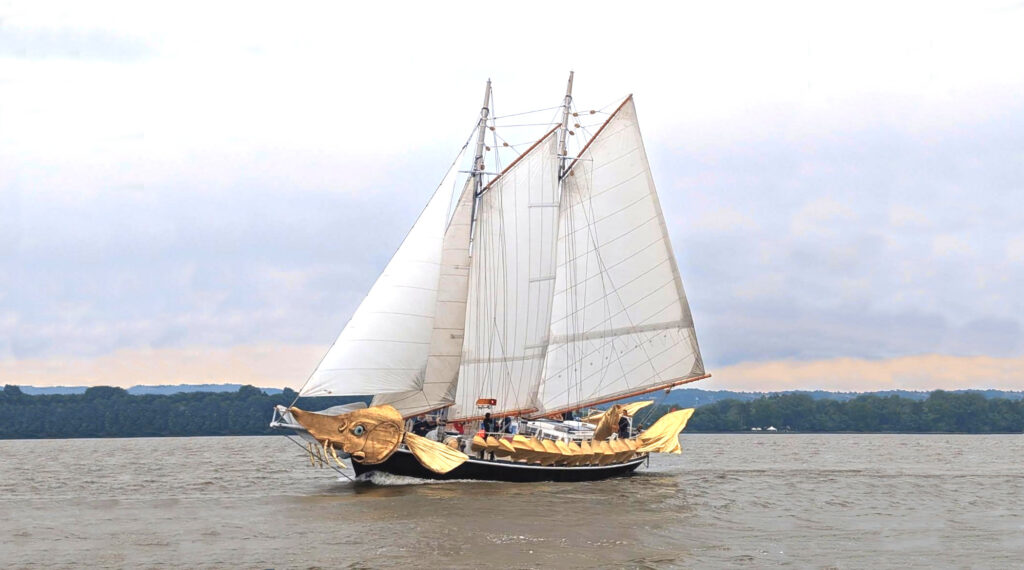Sailcargo on the rivers around New York
For the first time in generations, cargo has again been transported by sailing schooner across the rivers around New York. The delivery is part of a wider initiative to draw attention to sustainable sailcargo.
On 12 June 2025, a small solar-powered vessel quietly sails from the Molly Pitcher Inn to Bahrs Landing, where it will meet the sailing schooner Apollonia. Carrying a box of maple syrup, which had been transported by wind from northern New York, the vessel returns upstream, heading for Delicious Orchards.
“As far as I know, this small box of maple syrup that went to Delicious Orchards is probably the first cargo that has sailed up the river in probably 100 years,” says Rik van Hemmen of the Navesink Maritime Heritage Association, who is piloting the solar boat. “The river is free. You don’t have to asphalt it or anything. It’s just there and the wind is free.”
The schooner Apollonia, which carried the syrup from northern New York, is at the heart of this sustainable sea freight initiative: a growing marine freight movement along the Hudson that is reviving traditional trade routes using wind and used vegetable oil instead of traditional fossil fuels.
The Apollonia project was set up by its captain, Sam Merrett. Since 2020, the boat has transported more than 200,000 pounds of cargo using wind, tides and currents, according to the group’s website.
The Apollonia made its first stop in Bahrs Landing last year. On its return this month, it brought back “boat boxes” – goods that had been sustainably transported on the Apollonia and were for sale, as well as other products. While the goods were unloaded from the Apollonia, raw coffee beans from a warehouse in Carteret were loaded on board, destined for Germantown, New York, for roasting.
Built with a steel hull and a traditional gaff rig, the Apollonia was designed by J. Murray Watts and built in Baltimore in 1946. The schooner can carry up to 20,000 pounds of cargo. According to the project’s website, the boat’s variety of sails offers flexibility for different conditions on rivers.
French chocolate, fish from the Bronx
 Besides products sourced along the Hudson, the Apollonia also carries international cargo arriving by sailing ship from the Atlantic. One example is chocolate from French company Grain de Sail. Part of the sustainable shipping movement, Grain De Sail transports chocolate and coffee ingredients from Central America to France, where it manufactures its products, and then across the Atlantic to New York for sale.
Besides products sourced along the Hudson, the Apollonia also carries international cargo arriving by sailing ship from the Atlantic. One example is chocolate from French company Grain de Sail. Part of the sustainable shipping movement, Grain De Sail transports chocolate and coffee ingredients from Central America to France, where it manufactures its products, and then across the Atlantic to New York for sale.
“They deliver the chocolate to Brooklyn and then the Apollonia sells that chocolate during its voyages up the (Hudson) River,” Van Hemmen said. “That’s actually what it’s all about, showing people that it can also be done with water transport.”
Efforts are also being made in New York City to revitalise waterborne freight transport, explains Van Hemmen: “The New York City Economic Development Corporation is working hard to build small maritime terminals around New York Harbor to make it easier to transport freight by water through the five boroughs.”
One of the most ambitious projects is under construction at Hunts Point in the Bronx. “Hunts Point is the largest distribution centre for fruits, vegetables and fish in the world. They happen to be on the water, but they don’t transport anything by water, so New York City is now developing a maritime terminal there so they can do more distribution by water.”
A carbon-conscious future
The Apollonia’s visit to Highlands and Van Hemmen’s sunny cargo trip evoke nostalgic feelings in Monmouth County, where water transport was once an important part of life. “Originally, Monmouth County was the supplier of vegetables, fruit and oysters to New York City,” says Van Hemmen. “There was a very lively maritime trade between the Shrewsbury River and the coast from Raritan Bay to New York City; it was a big business.”
A century ago, shipowners sailed along the Navesink and Shrewsbury rivers with shallow draft schooners called Shrewsbury Packets, which were suitable for the shallow local waterways. “They were special vessels, specially designed for our trade on the very shallow rivers,” says Van Hemmen. “They could carry enough cargo to make the trip to New York City profitable.
Packets took care of local maritime trade until steamships, which could carry more cargo, prevailed. In the 1920s, trade along the Navesink and Shrewsbury rivers came to a halt as companies switched to railways and trucks.”
Today, the Apollonia and solar-powered ships like Van Hemmen’s do not represent a return to the past, but a reinvention of maritime logistics for a carbon-conscious future. The hope is that this will bring about a cultural shift, one load of syrup or bag of coffee at a time. Rik van Hemmen is down-to-earth about it: “None of us believe that sailboats can solve all our trucking problems, but by drawing attention to alternatives, we think we can change perceptions.”
Source: Steven Apezzato in the The Two River Times.
Headline photo: ©Casahudsonny for Apollonia.


